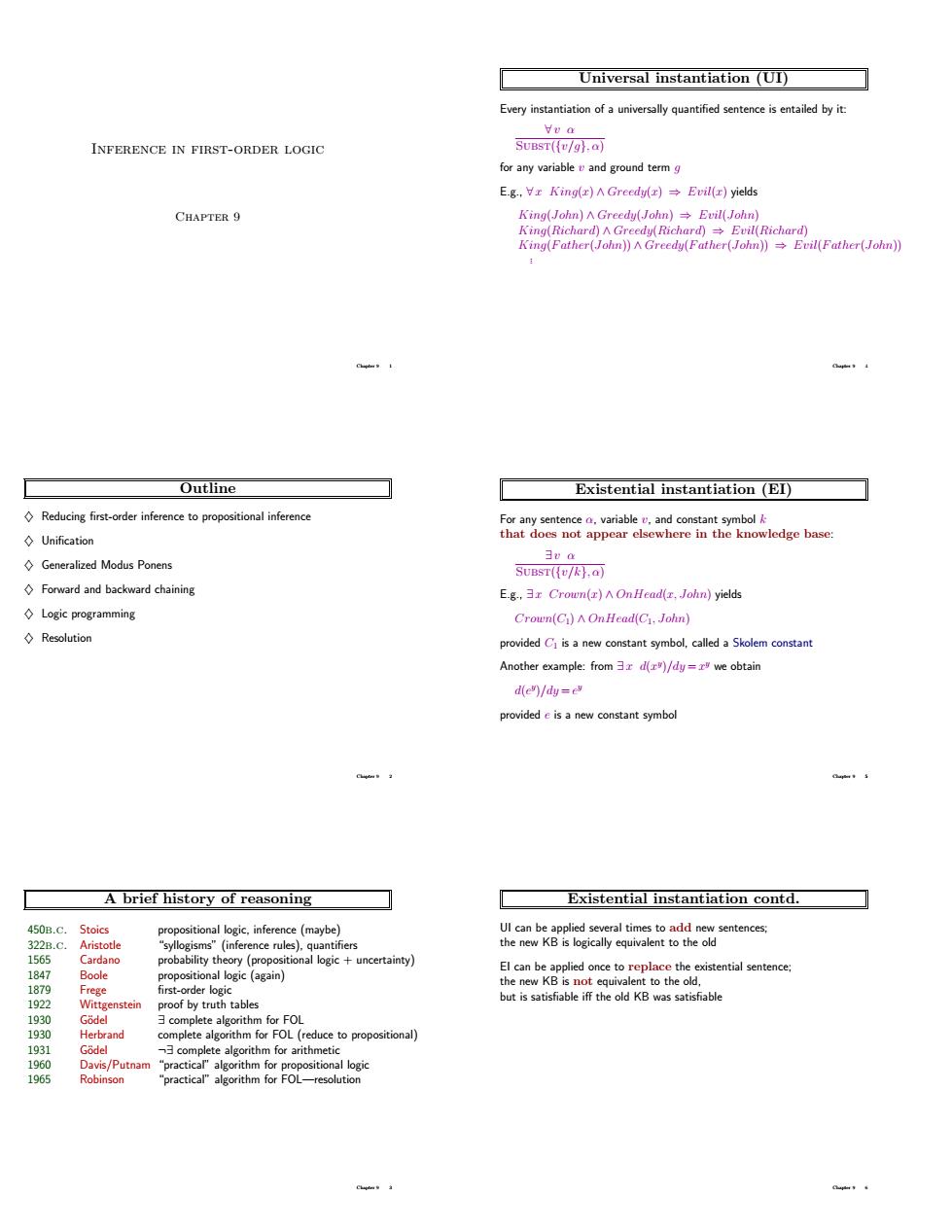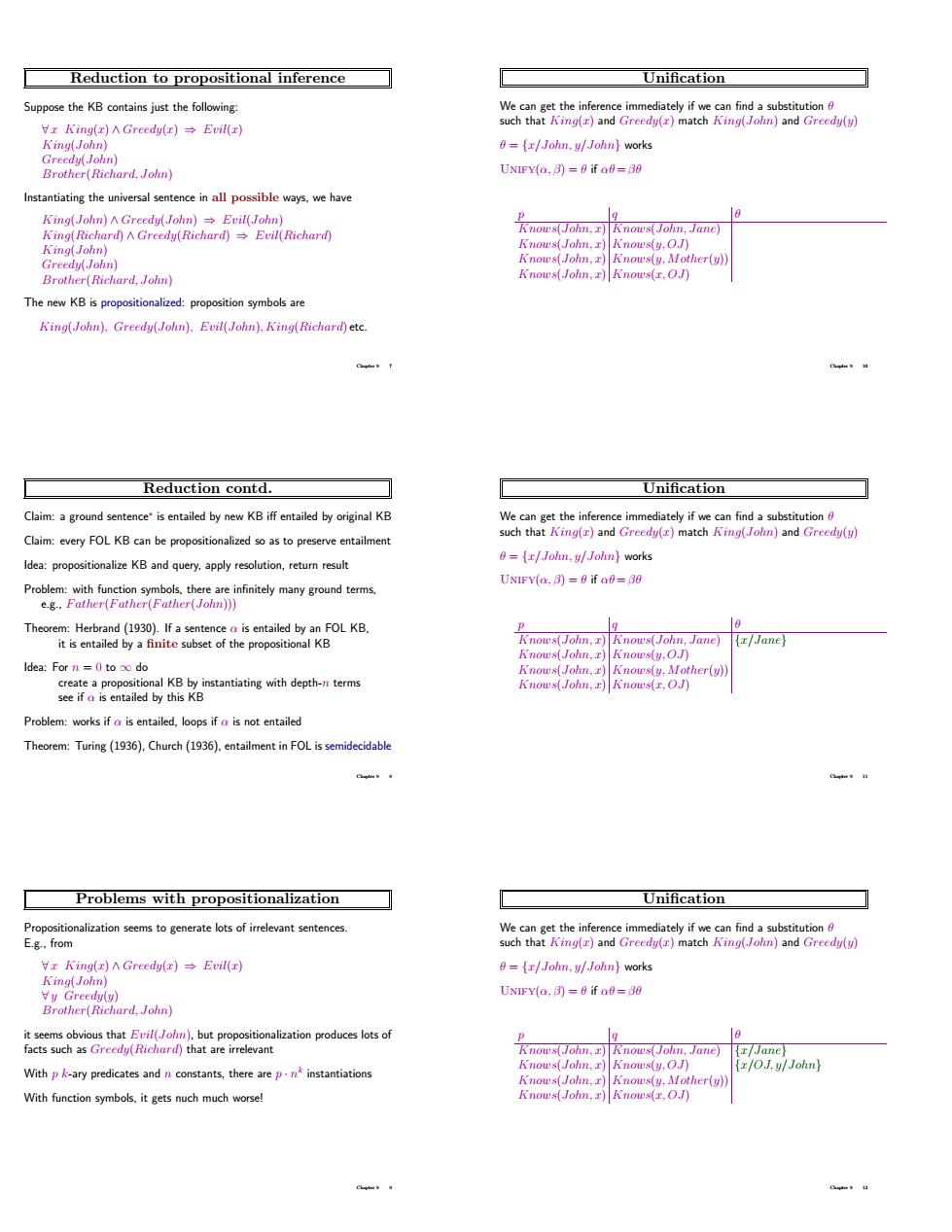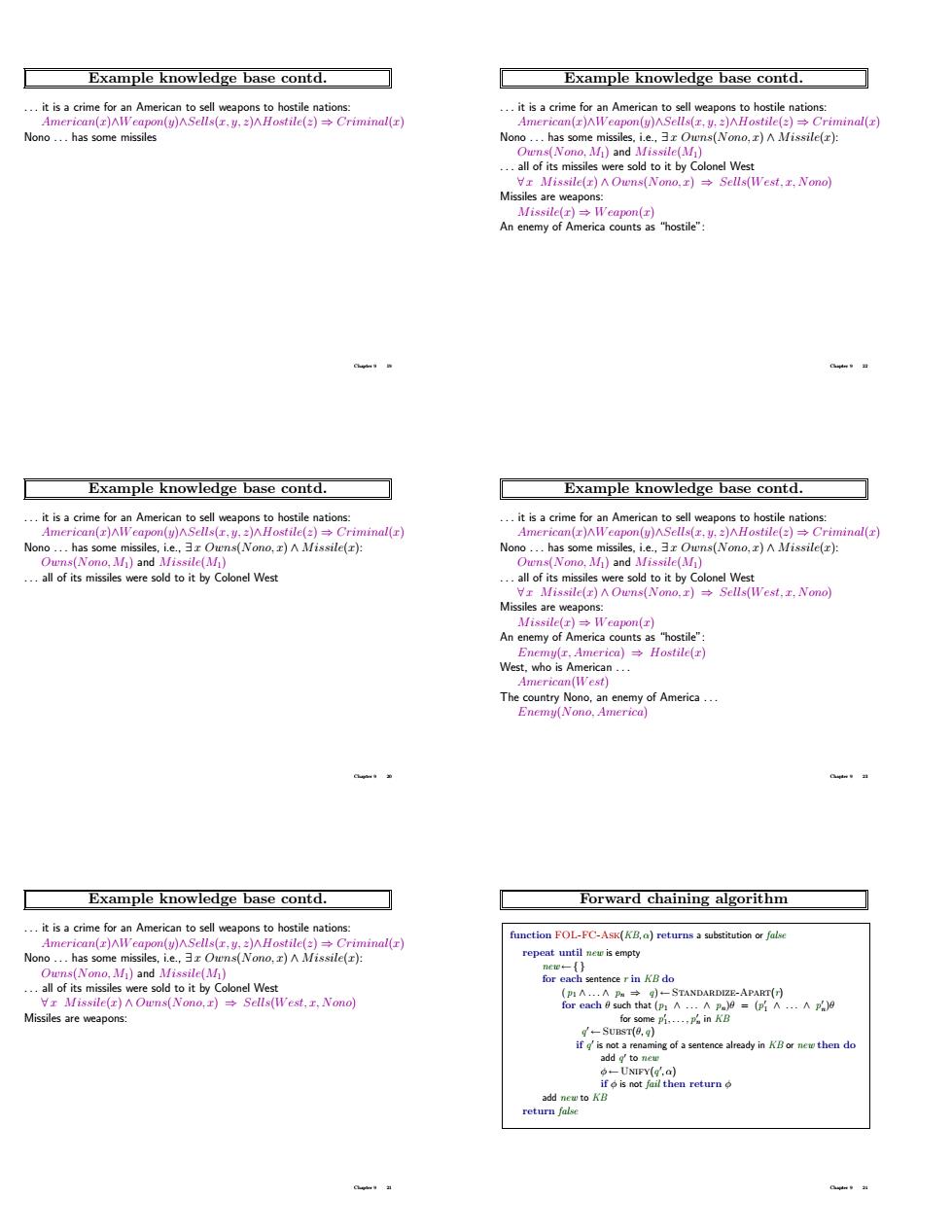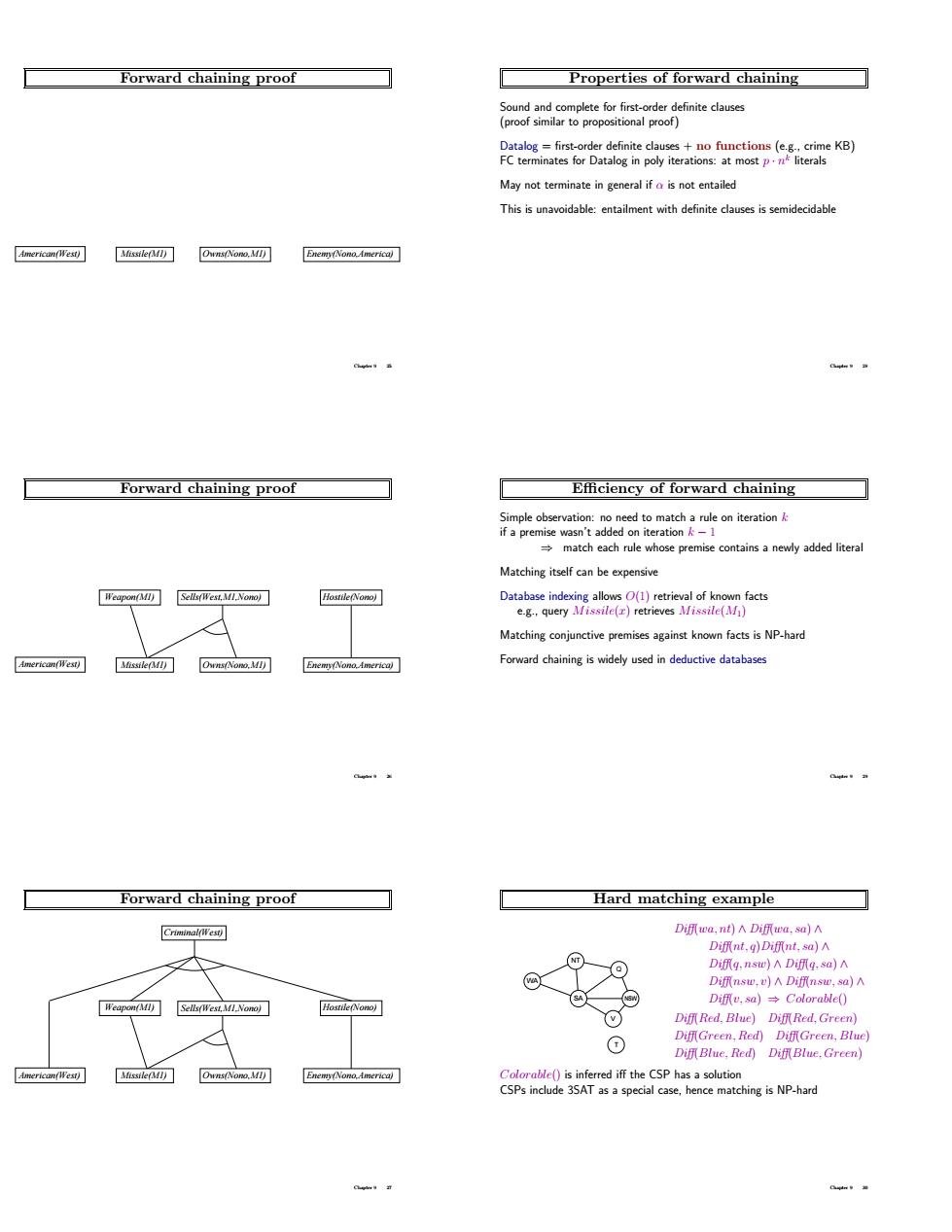
Universal instantiation (UI) Every instantiation of a universally guantified sentence is entailed by it: INFERENCE IN FIRST-ORDER LOGIC SUBST(/.a) for any variable u and ground term g Eg,r King(r)A Greedy(x)→Evil(r】yields CHAPTER 9 Outline Existential instantiation (EI) Reducing first-order inference to propositional inference that domotap ebae Generalized Modus Ponens s可 Forward and backward chaining EgCrown()AOnHead(z.John)yield Crown(C)A OnHeadiC.John) ◇Resolution dle/dy= provided e is a new constant symbol A brief history of reasoning Existential instantiation contd. e(maybe) sentence stential sentence and lete alg fLtdcetopropostional Dave/Putnam
Inference in first-order logic Chapter 9 Chapter 9 1 Outline ♦ Reducing first-order inference to propositional inference ♦ Unification ♦ Generalized Modus Ponens ♦ Forward and backward chaining ♦ Logic programming ♦ Resolution Chapter 9 2 A brief history of reasoning 450b.c. Stoics propositional logic, inference (maybe) 322b.c. Aristotle “syllogisms” (inference rules), quantifiers 1565 Cardano probability theory (propositional logic + uncertainty) 1847 Boole propositional logic (again) 1879 Frege first-order logic 1922 Wittgenstein proof by truth tables 1930 G¨odel ∃ complete algorithm for FOL 1930 Herbrand complete algorithm for FOL (reduce to propositional) 1931 G¨odel ¬∃ complete algorithm for arithmetic 1960 Davis/Putnam “practical” algorithm for propositional logic 1965 Robinson “practical” algorithm for FOL—resolution Chapter 9 3 Universal instantiation (UI) Every instantiation of a universally quantified sentence is entailed by it: ∀ v α Subst({v/g}, α) for any variable v and ground term g E.g., ∀ x King(x) ∧ Greedy(x) ⇒ Evil(x) yields King(John) ∧ Greedy(John) ⇒ Evil(John) King(Richard) ∧ Greedy(Richard) ⇒ Evil(Richard) King(Father(John)) ∧ Greedy(Father(John)) ⇒ Evil(Father(John)) ... Chapter 9 4 Existential instantiation (EI) For any sentence α, variable v, and constant symbol k that does not appear elsewhere in the knowledge base: ∃ v α Subst({v/k}, α) E.g., ∃ x Crown(x) ∧ OnHead(x, John) yields Crown(C1) ∧ OnHead(C1, John) provided C1 is a new constant symbol, called a Skolem constant Another example: from ∃ x d(x y )/dy = x y we obtain d(e y )/dy = e y provided e is a new constant symbol Chapter 9 5 Existential instantiation contd. UI can be applied several times to add new sentences; the new KB is logically equivalent to the old EI can be applied once to replace the existential sentence; the new KB is not equivalent to the old, but is satisfiable iff the old KB was satisfiable Chapter 9 6

Reduction to propositional inference Unification Suppose the KB contains just the following King(Jobn)and Greedu() 6=(r/John.u/John}works Brother(Richard.Joln) UNIFY(o.3)=0 if 0=86 Instantiatingthenivers ent inl possible wayswe have er(y) Brother(Richard.) The new KB is propositionalized:proposition symbols are King(Jom).Greedu(on).).King( Reduction contd. Unification Claim:every FOL KB can be propositionalized so as to preserve entailmer dea:propositionalize KB and query,apply resolution.return result -(r/John./John}works by a finite subset of the propos (John,Jane)/Jane ldea:Forn=0 to do Problem:works if o is entailed.loops if o is not entailed Problems with propositionalization Unification (/Joh./JohnY work UNIFY(o,闭=0fa0=38 Jane) z/OJ.u/John] With function symbo it gets nuch much worse Ko'JoMn,x)人nors(x,O.J刀
Reduction to propositional inference Suppose the KB contains just the following: ∀ x King(x) ∧ Greedy(x) ⇒ Evil(x) King(John) Greedy(John) Brother(Richard, John) Instantiating the universal sentence in all possible ways, we have King(John) ∧ Greedy(John) ⇒ Evil(John) King(Richard) ∧ Greedy(Richard) ⇒ Evil(Richard) King(John) Greedy(John) Brother(Richard, John) The new KB is propositionalized: proposition symbols are King(John), Greedy(John), Evil(John), King(Richard) etc. Chapter 9 7 Reduction contd. Claim: a ground sentence∗ is entailed by new KB iff entailed by original KB Claim: every FOL KB can be propositionalized so as to preserve entailment Idea: propositionalize KB and query, apply resolution, return result Problem: with function symbols, there are infinitely many ground terms, e.g., Father(Father(Father(John))) Theorem: Herbrand (1930). If a sentence α is entailed by an FOL KB, it is entailed by a finite subset of the propositional KB Idea: For n = 0 to ∞ do create a propositional KB by instantiating with depth-n terms see if α is entailed by this KB Problem: works if α is entailed, loops if α is not entailed Theorem: Turing (1936), Church (1936), entailment in FOL is semidecidable Chapter 9 8 Problems with propositionalization Propositionalization seems to generate lots of irrelevant sentences. E.g., from ∀ x King(x) ∧ Greedy(x) ⇒ Evil(x) King(John) ∀ y Greedy(y) Brother(Richard, John) it seems obvious that Evil(John), but propositionalization produces lots of facts such as Greedy(Richard) that are irrelevant With p k-ary predicates and n constants, there are p · n k instantiations With function symbols, it gets nuch much worse! Chapter 9 9 Unification We can get the inference immediately if we can find a substitution θ such that King(x) and Greedy(x) match King(John) and Greedy(y) θ = {x/John, y/John} works Unify(α, β) = θ if αθ = βθ p q θ Knows(John, x) Knows(John, Jane) Knows(John, x) Knows(y, OJ) Knows(John, x) Knows(y, Mother(y)) Knows(John, x) Knows(x, OJ) Chapter 9 10 Unification We can get the inference immediately if we can find a substitution θ such that King(x) and Greedy(x) match King(John) and Greedy(y) θ = {x/John, y/John} works Unify(α, β) = θ if αθ = βθ p q θ Knows(John, x) Knows(John, Jane) {x/Jane} Knows(John, x) Knows(y, OJ) Knows(John, x) Knows(y, Mother(y)) Knows(John, x) Knows(x, OJ) Chapter 9 11 Unification We can get the inference immediately if we can find a substitution θ such that King(x) and Greedy(x) match King(John) and Greedy(y) θ = {x/John, y/John} works Unify(α, β) = θ if αθ = βθ p q θ Knows(John, x) Knows(John, Jane) {x/Jane} Knows(John, x) Knows(y, OJ) {x/OJ, y/John} Knows(John, x) Knows(y, Mother(y)) Knows(John, x) Knows(x, OJ) Chapter 9 12

Unification Soundness of GMP Need to show that =/John,y/John)works provided thatp=p for all i UN1FY(a,到=8ifa8=8 Lemma:For any definite clause p.we have p=pe by Ul 1.(A..AB,→=(A..AA→g8=(h8A..AB,8→8 0 I.v/. her(John) 3.From 1 and 2,ge follows by ordinary Modus Ponens y/John.r/ Unification Example knowledge base ce immediately if The law that it is a crime for an Am can to sell v r/John.u/Jotn)works UNIFY(a.3)=e if 0=80 Prove that Col. on Jane) John.r/Mother(John) nows(.O zing ap eg.. Knows(en.O.n) -t鞋 Generalized Modus Ponens(GMP) Example knowledge base contd. where p'=p:e for all is Kin
Unification We can get the inference immediately if we can find a substitution θ such that King(x) and Greedy(x) match King(John) and Greedy(y) θ = {x/John, y/John} works Unify(α, β) = θ if αθ = βθ p q θ Knows(John, x) Knows(John, Jane) {x/Jane} Knows(John, x) Knows(y, OJ) {x/OJ, y/John} Knows(John, x) Knows(y, Mother(y)) {y/John, x/Mother(John)} Knows(John, x) Knows(x, OJ) Chapter 9 13 Unification We can get the inference immediately if we can find a substitution θ such that King(x) and Greedy(x) match King(John) and Greedy(y) θ = {x/John, y/John} works Unify(α, β) = θ if αθ = βθ p q θ Knows(John, x) Knows(John, Jane) {x/Jane} Knows(John, x) Knows(y, OJ) {x/OJ, y/John} Knows(John, x) Knows(y, Mother(y)) {y/John, x/Mother(John)} Knows(John, x) Knows(x, OJ) fail Standardizing apart eliminates overlap of variables, e.g., Knows(z17, OJ) Chapter 9 14 Generalized Modus Ponens (GMP) p1 0 , p2 0 , . . . , pn 0 , (p1 ∧ p2 ∧ . . . ∧ pn ⇒ q) qθ where pi 0 θ = piθ for all i p1 0 is King(John) p1 is King(x) p2 0 is Greedy(y) p2 is Greedy(x) θ is {x/John, y/John} q is Evil(x) qθ is Evil(John) GMP used with KB of definite clauses (exactly one positive literal) All variables assumed universally quantified Chapter 9 15 Soundness of GMP Need to show that p1 0 , . . . , pn 0 , (p1 ∧ . . . ∧ pn ⇒ q) |= qθ provided that pi 0 θ = piθ for all i Lemma: For any definite clause p, we have p |= pθ by UI 1. (p1 ∧ . . . ∧ pn ⇒ q) |= (p1 ∧ . . . ∧ pn ⇒ q)θ = (p1θ ∧ . . . ∧ pnθ ⇒ qθ) 2. p1 0 , . . . , pn 0 |= p1 0 ∧ . . . ∧ pn 0 |= p1 0 θ ∧ . . . ∧ pn 0 θ 3. From 1 and 2, qθ follows by ordinary Modus Ponens Chapter 9 16 Example knowledge base The law says that it is a crime for an American to sell weapons to hostile nations. The country Nono, an enemy of America, has some missiles, and all of its missiles were sold to it by Colonel West, who is American. Prove that Col. West is a criminal Chapter 9 17 Example knowledge base contd. . . . it is a crime for an American to sell weapons to hostile nations: Chapter 9 18

Example knowledge base contd. Example knowledge base contd. .it isa crimefor an American tosellw nal(r issiles e,3x (Nono.)Missile() no)and An enemy of A Example knowledge base contd. Example knowledge base contd. inal(z ninal(r) (Nono.M)and old to it by Colonel West (an Example knowledge base contd. Forward chaining algorithm n FOL-FC-ASK()retur repeat unt NDA gof a sentence already in or new then do a return
Example knowledge base contd. . . . it is a crime for an American to sell weapons to hostile nations: American(x)∧Weapon(y)∧Sells(x, y, z)∧Hostile(z) ⇒ Criminal(x) Nono . . . has some missiles Chapter 9 19 Example knowledge base contd. . . . it is a crime for an American to sell weapons to hostile nations: American(x)∧Weapon(y)∧Sells(x, y, z)∧Hostile(z) ⇒ Criminal(x) Nono . . . has some missiles, i.e., ∃ x Owns(Nono, x) ∧ Missile(x): Owns(Nono,M1) and Missile(M1) . . . all of its missiles were sold to it by Colonel West Chapter 9 20 Example knowledge base contd. . . . it is a crime for an American to sell weapons to hostile nations: American(x)∧Weapon(y)∧Sells(x, y, z)∧Hostile(z) ⇒ Criminal(x) Nono . . . has some missiles, i.e., ∃ x Owns(Nono, x) ∧ Missile(x): Owns(Nono,M1) and Missile(M1) . . . all of its missiles were sold to it by Colonel West ∀ x Missile(x) ∧ Owns(Nono, x) ⇒ Sells(West, x, Nono) Missiles are weapons: Chapter 9 21 Example knowledge base contd. . . . it is a crime for an American to sell weapons to hostile nations: American(x)∧Weapon(y)∧Sells(x, y, z)∧Hostile(z) ⇒ Criminal(x) Nono . . . has some missiles, i.e., ∃ x Owns(Nono, x) ∧ Missile(x): Owns(Nono,M1) and Missile(M1) . . . all of its missiles were sold to it by Colonel West ∀ x Missile(x) ∧ Owns(Nono, x) ⇒ Sells(West, x, Nono) Missiles are weapons: Missile(x) ⇒ Weapon(x) An enemy of America counts as “hostile”: Chapter 9 22 Example knowledge base contd. . . . it is a crime for an American to sell weapons to hostile nations: American(x)∧Weapon(y)∧Sells(x, y, z)∧Hostile(z) ⇒ Criminal(x) Nono . . . has some missiles, i.e., ∃ x Owns(Nono, x) ∧ Missile(x): Owns(Nono,M1) and Missile(M1) . . . all of its missiles were sold to it by Colonel West ∀ x Missile(x) ∧ Owns(Nono, x) ⇒ Sells(West, x, Nono) Missiles are weapons: Missile(x) ⇒ Weapon(x) An enemy of America counts as “hostile”: Enemy(x, America) ⇒ Hostile(x) West, who is American . . . American(West) The country Nono, an enemy of America . . . Enemy(Nono, America) Chapter 9 23 Forward chaining algorithm function FOL-FC-Ask(KB,α) returns a substitution or false repeat until new is empty new ← { } for each sentence r in KB do ( p1 ∧ . . . ∧ pn ⇒ q) ← Standardize-Apart(r) for each θ such that (p1 ∧ . . . ∧ pn)θ = (p 0 1 ∧ . . . ∧ p 0 n )θ for some p 0 1 , . . . , p 0 n in KB q 0 ← Subst(θ, q) if q 0 is not a renaming of a sentence already in KB or new then do add q 0 to new φ ← Unify(q 0 ,α) if φ is not fail then return φ add new to KB return false Chapter 9 24

Forward chaining proof Properties of forward chaining th Pebymaaamka) This is unavoidable:entailment with definite clauses is semidecidable Forward chaining proof Efficiency of forward chaining Matching Haopo(MT)SiFes.MI.Nom) Forward chaining is widely used in deductivedatab Forward chaining proof Hard matching example D,ns)AD项4,a)A Dif Red.Blwe Dif Red.Gree f Green.Red).Blue D所Be chingis NP-hard
Forward chaining proof American(West) Missile(M1) Owns(Nono,M1) Enemy(Nono,America) Chapter 9 25 Forward chaining proof Hostile(Nono) American(West) Missile(M1) Owns(Nono,M1) Enemy(Nono,America) Weapon(M1) Sells(West,M1,Nono) Chapter 9 26 Forward chaining proof Hostile(Nono) American(West) Missile(M1) Owns(Nono,M1) Enemy(Nono,America) Weapon(M1) Criminal(West) Sells(West,M1,Nono) Chapter 9 27 Properties of forward chaining Sound and complete for first-order definite clauses (proof similar to propositional proof) Datalog = first-order definite clauses + no functions (e.g., crime KB) FC terminates for Datalog in poly iterations: at most p · n k literals May not terminate in general if α is not entailed This is unavoidable: entailment with definite clauses is semidecidable Chapter 9 28 Efficiency of forward chaining Simple observation: no need to match a rule on iteration k if a premise wasn’t added on iteration k − 1 ⇒ match each rule whose premise contains a newly added literal Matching itself can be expensive Database indexing allows O(1) retrieval of known facts e.g., query Missile(x) retrieves Missile(M1) Matching conjunctive premises against known facts is NP-hard Forward chaining is widely used in deductive databases Chapter 9 29 Hard matching example Victoria WA NT SA Q NSW V T Diff(wa, nt) ∧ Diff(wa, sa) ∧ Diff(nt, q)Diff(nt, sa) ∧ Diff(q, nsw) ∧ Diff(q, sa) ∧ Diff(nsw, v) ∧ Diff(nsw, sa) ∧ Diff(v, sa) ⇒ Colorable() Diff(Red, Blue) Diff(Red, Green) Diff(Green, Red) Diff(Green, Blue) Diff(Blue, Red) Diff(Blue, Green) Colorable() is inferred iff the CSP has a solution CSPs include 3SAT as a special case, hence matching is NP-hard Chapter 9 30